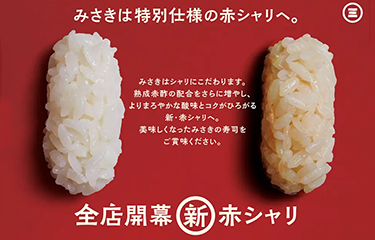Many high-end sushi shops in Japan are starting to prepare their dishes with red vinegar in a similar fashion to how sushi chefs prepared the original nigiri sushi style, edomae, over two centuries ago.
In March of this year, the Tokyo-based restaurant chain Kaiten Sushi Misaki started to heavily emphasize red vinegar in its shari (sushi rice). The improved “new red shari” uses red vinegar made from sake lees that slowly ages for two years, and the company increased the proportion of red vinegar compared to its previous offerings.
“Aka-shari, which refers to shari made with red vinegar, is still served mainly in high-end sushi restaurants as an important factor in bringing out the umami [taste] of the ingredients and [ensuring] the deliciousness of sushi,” the company said in a press release. “At Kaiten Sushi Misaki, when we held a ‘Natural Fish and Red Shari Fair’ in December, which offered aka-shari with an increased proportion of red vinegar, we received many comments from customers that the shari was delicious. In order for customers to enjoy more delicious sushi, we will now upgrade the aka-shari offered at all Kaiten Sushi Misaki stores.”
The new emphasis on red vinegar is an example of restaurants creating sushi concoctions that hearken back to the dish’s roots, and the edomae style.
The name edomae, or roughly translated as “Edo front,” stems from the origins of sushi. Nigiri sushi developed in Tokyo, which used to be called Edo, between 1818 and 1830, as fast food sold from stalls. As refrigeration was nonexistent the toppings –which included tuna, bonito, halibut, and gizzard shad – were limited to what was available from Tokyo Bay.
Upon its introduction, it became a competitor to the ...
Photo courtesy of Kaiten Sushi Misaki








